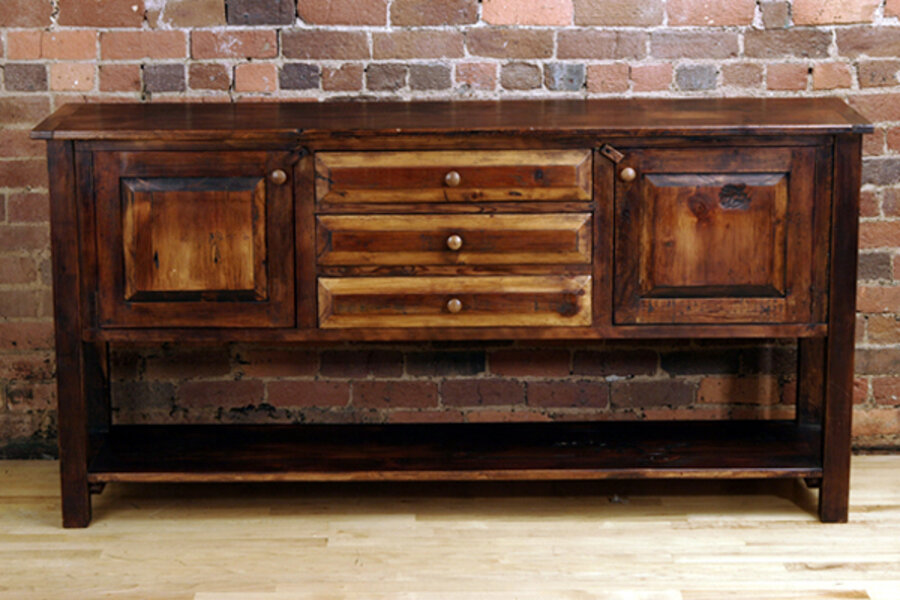Stylish new products made from repurposed materials
I remember that when I was a kid, my dad was the master of fixing things. He had his work cut out for him. From tiny radio wires that needed soldering to roof shingles that seemed perennially to have seen better days, there was a lot breaking and wearing out around our house.
He kept his arsenal of spare parts in a room in the basement. Jars of various sizes of washers and screws were labeled and carefully inventoried on handmade Lazy Susan-type storage systems. These involved used instant coffee jars nailed to a piece of wood. Tools of every sort were carefully stowed on neat hooks made of old horseshoes.
Need a bookshelf? My dad could lash one together in 20 minutes using the wood from a shed he’d torn down the year before. The results were usually far more interesting and stylish than pieces you could ever find in a store.
The notion of trashing a used nail (they can be unbent with a little careful hammering, you know) or a broken rake was novel to him. Stupid even. He’d come through the Depression and three wars, after all – things just weren’t thrown away in his day.
Come to think of it, my dad and people of his era were eco-friendly and green long before it was a necessary movement. It was simply good, old-fashioned horse sense.
Of course, the notion of fixing a transistor radio – or even a telephone – back in those days was a doable option.
Not too long ago, I was standing in a cellphone store waiting patiently for my moment to buy the newest item. The man in front of me had a serious problem, and was drawing the ire of both customers and staff. He’d tried to fix a bug in his phone and inadvertently destroyed it.
The cellphone people smirked and sighed – which is understandable on one level, but also serves to demonstrate that the “fixers” of my dad’s day are not only an eccentric notion now, they can be an annoyance. Why try to fix what could so easily be replaced?
We throw away lots of stuff – you don’t need me to tell you that the landfills are jammed with things that could have found new life. And if you read this column regularly, you’re probably well aware of giant trash swirl the size of Texas in the Pacific Ocean that’s the result of discarded plastic.
During the onset of the current recession, more than one style columnist pondered in print whether the green movement had met its match. The growing concern was that consumers might become so concerned with the cost of things that they’d throw their eco-friendly proclivities into the nearest garbage pail.
I’m happy to say that as we’re seeing new products for 2010 come to market, the green movement has clearly survived and thrived. Here are a few remarkable products made from repurposed materials that are really stylish and on-trend – and I’m pretty sure my dad would think were really cool:
Barnwood Classics Furniture Collection (full disclosure: a company I recently started representing) makes a gorgeous collection of furniture from the wood in antique barns, covered bridges, and other old structures that have either fallen down on their own or have been deemed too unstable for further use. Much of the wood, which comes from old tobacco barns in Pennsylvania, dates back 280 years. By recycling the wood into furniture, customers get a sort of hybrid piece of functional art to use in their homes. Vintage and imbued with history while at the same time new and sturdy.
Jerry Kott’s Khrysalis Color Block Lights – take a wine bottle, insert a light. Sounds simple. Except these chandeliers and table lamps are so much more. Mr. Kott cuts the bottles into blocks and then frosts both the interior and the exterior of the glass. He then fuses them into blocks of color with various shapes. The result is a harmoniously hued, organic-meets-modern collection. He also makes color block vases.
Alexandra Ferguson’s Recycled Water Bottle Pillows brings to mind something that sounds more crunchy than cushy, but these clever cushions are made from 100 percent post-consumer recycled felt derived from, yes, recycled water bottles that are snatched away before they reach the landfill. It takes about four water bottles to make each pillow cover. Ms. Ferguson then crafts these into very cool designs that range from graphically botanical to all-out chatty. My favorite is “Be Nice or Leave” – a rule we can all live by.
Carrie Leber writes the blog Bloomacious.org and owns the PR firm Leber Media Group.
-----
Usually, Alexandra Marks blogs twice a week in this spot about her green and budget-friendly restoration of a 1902 farmhouse in Connecticut. She will resume blogging on March 23. Click here to find all her blog posts and articles.





